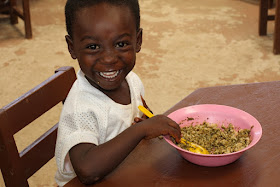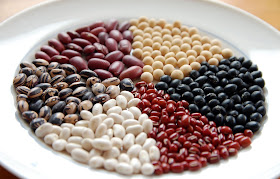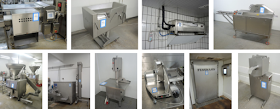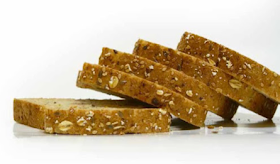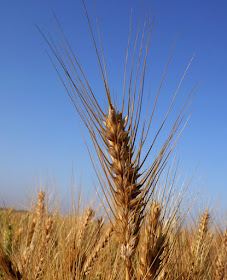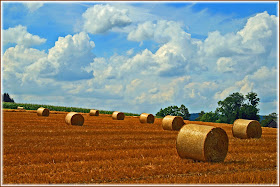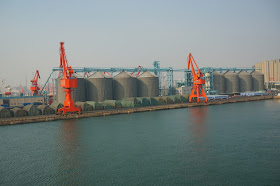 |
| The Kalmar Lantmän feedmill in Kalmar, Sweden |
How we feed the world’s ever growing population is the big question for the milling industry. Milling and Grain magazine goes in search of answers, on a behind the scenes tour of the Van Aarsen-built, Kalmar Lantmän project - the most modern feedmill in the world - to find out how the technology in this new mill sets a standard for the future.
by Darren Parris, Milling and Grain
First published in Milling and Grain, August 2015
1/3: The challenge
There is almost nothing more important in life than feeding the planet. A wise man once pointed out that we must feed nine billion people by 2050. However, as a humble writer, I have seen firsthand round the globe and on every continent, just how very difficult this task is going to be.
Having visited many mills throughout both the developed and developing world, I have become fascinated at the challenges facing the modern miller; when we consider probably upwards of 80 percent of everything we consume has somehow been touched by the milling process, be it the simple process of flours and grains for breads, biscuit’s, pastry, crisps etc or your rice’s, pasta and semolina’s or indeed your coffee or chocolates how we mill has become ever more important.
And, nowhere is this more important than the production of feeds for all the species that give us our milk, cheeses, meats and fish.
When we consider the Feed Conversion Ratio (FCR) for most species of edible animals, it is clear that we must get the feed right. As a quick recap, the FCR refers to how many pounds (lb) of feed it takes to produce a pound of gained meat for human consumption. Below are some typical examples of FCR for some of the most common eaten species:
by Darren Parris, Milling and Grain
First published in Milling and Grain, August 2015
1/3: The challenge
There is almost nothing more important in life than feeding the planet. A wise man once pointed out that we must feed nine billion people by 2050. However, as a humble writer, I have seen firsthand round the globe and on every continent, just how very difficult this task is going to be.
Having visited many mills throughout both the developed and developing world, I have become fascinated at the challenges facing the modern miller; when we consider probably upwards of 80 percent of everything we consume has somehow been touched by the milling process, be it the simple process of flours and grains for breads, biscuit’s, pastry, crisps etc or your rice’s, pasta and semolina’s or indeed your coffee or chocolates how we mill has become ever more important.
And, nowhere is this more important than the production of feeds for all the species that give us our milk, cheeses, meats and fish.
When we consider the Feed Conversion Ratio (FCR) for most species of edible animals, it is clear that we must get the feed right. As a quick recap, the FCR refers to how many pounds (lb) of feed it takes to produce a pound of gained meat for human consumption. Below are some typical examples of FCR for some of the most common eaten species:
- Beef cattle - 5.5 to 6.5lb of feed for each pound of gain
- Chickens - 2 to 3lb of feed for each pound of gain
- Pigs - 2.18 to 5.91lb of feed for each pound of gain
- Fish – 1.2 to1.8lb of feed for each pound of gain
You can see that these FCRs vary considerably depending upon the species, with fish and poultry being the most efficient and therefore considered the most sustainable.
Often some of the ingredients in feed pellets, etc contains food already suitable for human consumption. Therefore from a sustainable perspective it has become ever more important to make sure the final feed compound is containing all the right ingredients to allow it to be an effective feed that puts the right nutrients back into the food for human consumption.
It is at this point you realise just how much more complex the process is for milling feeds than it is for flour, chocolates, rice or coffee, etc. When we consider what we want from our meats, and that they should be nutritious for us, they must contain the correct levels of minerals, vitamins, amino acids, proteins and carbohydrates to mention just a few nutritional expectations.
Therefore, the art of farming good healthy and nutritious animals with a good FCR will often come down to a good feed supplies and as with many recipes in life, every farmer will have his own preferences about what goes into their feeds for their animals.
Read the full article in Milling and Grain HERE.
Often some of the ingredients in feed pellets, etc contains food already suitable for human consumption. Therefore from a sustainable perspective it has become ever more important to make sure the final feed compound is containing all the right ingredients to allow it to be an effective feed that puts the right nutrients back into the food for human consumption.
It is at this point you realise just how much more complex the process is for milling feeds than it is for flour, chocolates, rice or coffee, etc. When we consider what we want from our meats, and that they should be nutritious for us, they must contain the correct levels of minerals, vitamins, amino acids, proteins and carbohydrates to mention just a few nutritional expectations.
Therefore, the art of farming good healthy and nutritious animals with a good FCR will often come down to a good feed supplies and as with many recipes in life, every farmer will have his own preferences about what goes into their feeds for their animals.
Read the full article in Milling and Grain HERE.
The Global Miller
This blog is maintained by The Global Miller staff and is supported by the magazine GFMT
which is published by Perendale Publishers Limited.
For additional daily news from milling around the world: global-milling.com





